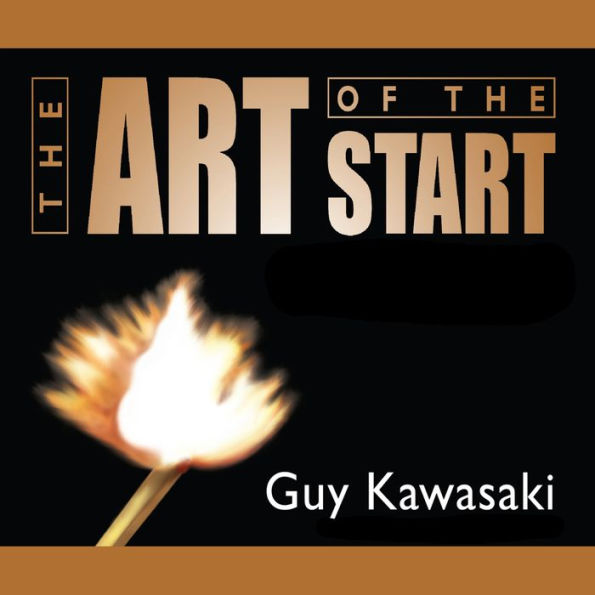Forbes columnist Guy Kawasaki developed this book from a "Boot-Camp for Start-Ups" that he conducted. The Art of the Start covers all aspects of the start-up: the goals of the venture, the positioning in the marketplace; the business plan; cash management; recruiting; raising capital partnering; branding; and more. This book was written with the realities of the post-1999 stagnant economy specifically in mind. Kawasaki, who is known as the "Father of Evangelism Marketing," has a well-earned reputation for motivating entrepreneurs.
The Art of the Start: The Time-Tested, Battle-Hardened Guide for Anyone Starting Anything
What does it take to turn ideas into action? What are the elements of a perfect pitch? How do you win the war for talent? How do you establish a brand without bucks? These are some of the issues everyone faces when starting or revitalizing any undertaking, and Guy Kawasaki, former marketing maven of Apple Computer, provides the answers.
The Art of the Start will give you the essential steps to launch great products, services, and companies-whether you are dreaming of starting the next Microsoft or a not-for-profit that's going to change the world. It also shows managers how to unleash entrepreneurial thinking at established companies, helping them foster the pluck and creativity that their businesses need to stay ahead of the pack. Kawasaki provides readers with GIST-Great Ideas for Starting Things-including his field-tested insider's techniques for bootstrapping, branding, networking, recruiting, pitching, rainmaking, and, most important in this fickle consumer climate, building buzz.
At Apple, Kawasaki helped turn ordinary customers into fanatics. As founder and CEO of Garage Technology Ventures, he has tested his iconoclastic ideas on real-world start-ups. And as an irrepressible columnist for Forbes, he has honed his best thinking about The Art of the Start.
1102040659
The Art of the Start will give you the essential steps to launch great products, services, and companies-whether you are dreaming of starting the next Microsoft or a not-for-profit that's going to change the world. It also shows managers how to unleash entrepreneurial thinking at established companies, helping them foster the pluck and creativity that their businesses need to stay ahead of the pack. Kawasaki provides readers with GIST-Great Ideas for Starting Things-including his field-tested insider's techniques for bootstrapping, branding, networking, recruiting, pitching, rainmaking, and, most important in this fickle consumer climate, building buzz.
At Apple, Kawasaki helped turn ordinary customers into fanatics. As founder and CEO of Garage Technology Ventures, he has tested his iconoclastic ideas on real-world start-ups. And as an irrepressible columnist for Forbes, he has honed his best thinking about The Art of the Start.
The Art of the Start: The Time-Tested, Battle-Hardened Guide for Anyone Starting Anything
What does it take to turn ideas into action? What are the elements of a perfect pitch? How do you win the war for talent? How do you establish a brand without bucks? These are some of the issues everyone faces when starting or revitalizing any undertaking, and Guy Kawasaki, former marketing maven of Apple Computer, provides the answers.
The Art of the Start will give you the essential steps to launch great products, services, and companies-whether you are dreaming of starting the next Microsoft or a not-for-profit that's going to change the world. It also shows managers how to unleash entrepreneurial thinking at established companies, helping them foster the pluck and creativity that their businesses need to stay ahead of the pack. Kawasaki provides readers with GIST-Great Ideas for Starting Things-including his field-tested insider's techniques for bootstrapping, branding, networking, recruiting, pitching, rainmaking, and, most important in this fickle consumer climate, building buzz.
At Apple, Kawasaki helped turn ordinary customers into fanatics. As founder and CEO of Garage Technology Ventures, he has tested his iconoclastic ideas on real-world start-ups. And as an irrepressible columnist for Forbes, he has honed his best thinking about The Art of the Start.
The Art of the Start will give you the essential steps to launch great products, services, and companies-whether you are dreaming of starting the next Microsoft or a not-for-profit that's going to change the world. It also shows managers how to unleash entrepreneurial thinking at established companies, helping them foster the pluck and creativity that their businesses need to stay ahead of the pack. Kawasaki provides readers with GIST-Great Ideas for Starting Things-including his field-tested insider's techniques for bootstrapping, branding, networking, recruiting, pitching, rainmaking, and, most important in this fickle consumer climate, building buzz.
At Apple, Kawasaki helped turn ordinary customers into fanatics. As founder and CEO of Garage Technology Ventures, he has tested his iconoclastic ideas on real-world start-ups. And as an irrepressible columnist for Forbes, he has honed his best thinking about The Art of the Start.
16.99
In Stock
5
1

The Art of the Start: The Time-Tested, Battle-Hardened Guide for Anyone Starting Anything

The Art of the Start: The Time-Tested, Battle-Hardened Guide for Anyone Starting Anything
FREE
with a B&N Audiobooks Subscription
Or Pay
$16.99
16.99
In Stock

Editorial Reviews
Product Details
| BN ID: | 2940170492886 |
|---|---|
| Publisher: | Tantor Audio |
| Publication date: | 01/19/2009 |
| Edition description: | Unabridged |
Videos

From the B&N Reads Blog
